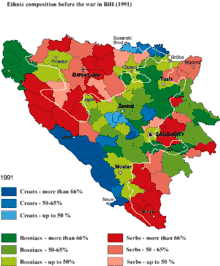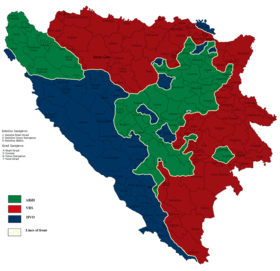Proposed Bosniak republic
A Bosniak republic, or "Bosniak entity", was proposed during the Bosnian War when plans for the partition of Bosnia and Herzegovina were made. It would either be established as one of three ethnic states in a loose confederation,[1] or as an independent "Muslim state" in the area controlled by the Bosnian Army, as proposed by Islamists.[2] Thus, the Bosniak-inhabited territories or Bosnian Army-controlled area (the Republic of Bosnia and Herzegovina) would become a Bosniak state, as Republika Srpska was for the Bosnian Serbs and Herzeg-Bosnia for the Bosnian Croats. The failed 1992 Serb–Croat Graz agreement would see a small Bosniak buffer state, pejoratively called "Alija's Pashaluk" on a map displayed during the discussions.[3] The Owen-Stoltenberg plan (July 1993) would give Bosniaks 30% of territory, including ca. 65% of the Bosniak population (according to the 1991 census).[1] In February 1994, the Party of Democratic Action (SDA) proposed a Bosniak state in which Serbs and Croats would be national minorities.[2] The Dayton Agreement (November–December 1995) ended the war and created the federal republic of Bosnia and Herzegovina (BiH), made up of two entities, the Bosniak and Croat-inhabited Federation of Bosnia and Herzegovina (FBiH), and the Serb-inhabited Republika Srpska (RS). As noted by international relations expert Niels van Willigen: "Whereas the Bosnian Croats and Bosnian Serbs could identify themselves with Croatia or Serbia respectively, the absence of a Bosniak state made the Bosniaks firmly committed to Bosnia as a single political entity."[4]
Propaganda texts appeared in 1996, after the war, calling for a Bosniak state.[5] Secular Bosniaks have warned that a partition of the state would lead their people to Islamic fundamentalism.[6] There has been proposals of secession of RS, as well as its abolition.
 Ethnic composition in 1991
Ethnic composition in 1991 Military control before Dayton (1995)
Military control before Dayton (1995) Ethnic composition in 2013
Ethnic composition in 2013
See also
References
- Kostić 2007, p. 78.
- Velikonja 2003, p. 278.
- Blaine, Harden (1992-05-08). "Warring Factions Agree on Plan to Divide up Former Yugoslavia". The Washington Post. Retrieved 2009-08-11.
- Niels van Willigen (18 July 2013). Peacebuilding and International Administration: The Cases of Bosnia and Herzegovina and Kosovo. Routledge. pp. 52–. ISBN 978-1-134-11725-3.
- FBIS Daily Report: East Europe. The Service. 1996. p. 20.
- Timothy Garton Ash (2000). History of the present: essays, sketches and despatches from Europe in the 1990s. Penguin. p. 374. ISBN 978-0-14-028318-1.
Sources
- Kostić, Roland (2007). Ambivalent Peace: External Peacebuilding Threatened Identity and Reconciliation in Bosnia and Herzegovina. Ambivalent Peace. pp. 78–. ISBN 978-91-506-1950-8.CS1 maint: ref=harv (link)
- Trnka, Kasim (2000). Konstitutivnost naroda: povodom odluke Ustavnog suda Bosne i Hercegovine o konstitutivnosti Bošnjaka, Hrvata i Srba i na nivou entiteta. Vijeće Kongresa bošnjačkih intelektualaca. ISBN 978-9958-47-072-1.CS1 maint: ref=harv (link)
- Velikonja, Mitja (2003). Religious Separation and Political Intolerance in Bosnia-Herzegovina. Texas A&M University Press. pp. 278–. ISBN 978-1-60344-724-9.CS1 maint: ref=harv (link)
Further reading
- Ajanović, M. (1995). [Manifesto of a Bosniak republic]. Tuzla.